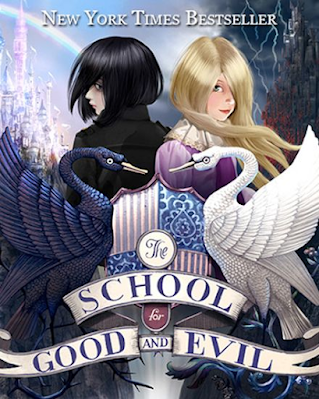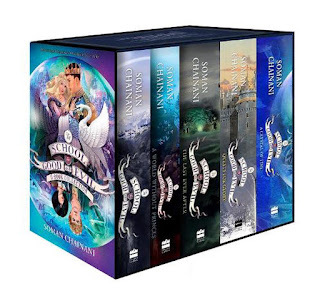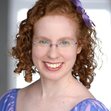Netflix Is Adapting The School for Good and Evil, So I Read the First Book!
The School for Good and Evil is a middle grade book series released in 2013 with a similar plot to Ever After High and Descendants and with all the ambition of Harry Potter. Considering how popular this fairy tale-inspired series seems to be, I'm surprised I never heard of it until a little over a week ago when I learned that Netflix is turning it into a movie. Perhaps one of the reasons it was so overlooked is its super generic title, which sounds like it could be about literally anything. Most fictional stories are about the battle between good and evil. A better title would have been The School for Princesses and Witches, which would have been more eye-catching to lovers of fairy tales. Maybe the vagueness is good, though, since this book contains many horror elements that could scare off young fairy tale aficionados or particularly sensitive older ones like myself.

When I began reading The School for Good and Evil, I had many questions that were mostly resolved by the end, but not entirely. The author threw around so many contradictory ideas that the school that made no sense, even for a fantasy world. Ever After High, which came out the same year as this book, did a better job of creating a school for fairy tale characters because the classes weren't separated based on who is a "royal" or a "rebel," meaning students could study whatever they wanted just like a real school. The characters were all descendants of the famous ones from storybooks, which eliminated the issue of altering their childhoods. Here, students are kidnapped and forced to attend whichever school is chosen for them whether they want to or not, particularly in the case of Sophie, who spent her entire life dreaming of becoming a princess and is essentially thrown into prison with a bunch of monsters who debate whether they should kill her or not upon meeting her for the first time. This school is allegedly where every famous fairy tale character got their start including ones like Cinderella, Snow White, and Rapunzel, who all spent their childhoods in isolation and abuse. Attending a school where they were supported by friends and teachers would have changed the outcomes of their stories, but that is never addressed here.

Questionable world-building aside, the plot is a mash-up of Wicked and Descendents 3 . It focuses on Sophie and Agatha, two girls who are the best of friends but could not be more different. Sophie wears fancy dresses and walks around in glass slippers on a daily basis (ouch), dreaming of the day she'll get kidnapped and begin her fairy tale, while Agatha is a goth recluse who lives in a graveyard and carries around dead animals to remind everyone about the value of life. When Agatha is sent to the "good" school filled with other wannabe princesses and valiant princes while Sophie is sent to the "evil" school and forced to take classes about how to make herself more ugly, Sophie flies into a jealous rampage that leads her down a path befitting of her new school. The book raises many questions about what "good" and "evil" really mean by making the good characters shallow and superficial, while the evil characters have an honor system and prefer to be ugly so they can be appreciated for their talents rather than their looks. This makes the mix-up between Sophie and Agatha particularly confusing because Sophie is no different from any of the other girls at the "good" school who probably would have responded just like her in her place. Meanwhile, Agatha, who is supposed to be "good," refuses to let Sophie live out her dream because of her selfish desire to have her all to herself. Of course, the ambiguity of human nature was probably the whole point that the author was driving at. It just could have been done better if everyone wasn't so fixated on their appearances. If all the villains who attended the school were taught to value ugliness over beauty, how would they explain the jealousy of wicked stepmothers?
I can understand why someone might read this book and think it would make for a good movie. There are a lot of cinematic elements and horror movie imagery reminiscent of the Harry Potter series. Parts of it would need to be toned down if the movie has a similar target audience as the books of 9-12 years old, which I personally think is too young for this series. There were several things that I felt were inappropriate for middle-grade readers, including forced dressing and undressing that I would equate to a minor form of assault. I hate to admit it, but I could tell this book was written by a man due to the gratuitous nudity of young girls as a result of magical transformations as well as the way he viewed girls as being obsessed with their appearances and finding boyfriends and pretty much nothing else. Still, if done right, this story would make for a compelling film. Sophie and Agatha are great characters with different strengths and weaknesses. Agatha puts up with Sophie's abuse out of her desire to always be with her, while Sophie suffers in a school she never asked to attend and is willing to take down everyone and everything in it to get what she wants. As someone who also dreamed of being a princess, I was a little triggered by the accusations the book threw at her about how wanting to be the heroine of a fairy tale doesn't necessarily make you a good person. The book really got under my skin and made me think even when I wasn't reading it, so I give the author props for that.

There are currently six books in this series, and they are quite long, so I doubt I will be reading the rest. However, I will probably watch the Netflix movie to see how the dark imagery described in the book translates to the screen. There's an interview with the author at the end of this book about it being picked up for a film by Universal Studios back in 2013, but I doubt this is the same movie. I can understand why a well-known studio would have wanted to bring such a visual concept to the screen, so I'm not sure what happened to that version of the film. I suppose Netflix had to wait a few years to get the rights from Universal once the project was canceled. Considering how risqué Netflix tends to be with their content, I hope no children get traumatized by this film. Even though I was a little traumatized by the book, myself, I found it to be a thought-provoking experience overall. I recommend The School for Good and Evil series to people who enjoy comics like Fables from Vertigo Comics or Grimm Fairy Tales from Zenescope, which mix the horror elements with well-known fairy tales. The Netflix film does not have a release date yet, but it is said to come out this fall.



